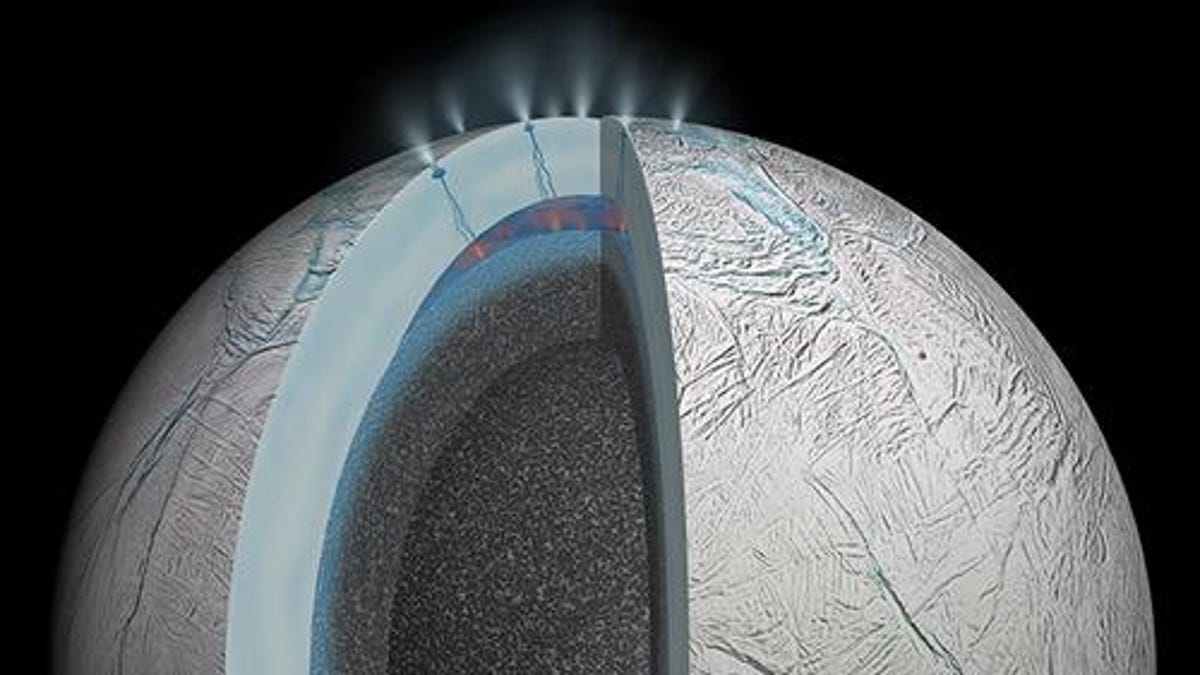NASA scientists build ‘primordial ocean’ to re-create origins of life
Putting the young Earth's oceans in a glass provides tantalizing clues as to where we might find life in deep space.

The ocean underneath Saturn's moon Enceladus may contain the necessary ingredients for life to begin.
If life can find a way to thrive in the deepest depths of Earth's oceans, what's stopping it from existing elsewhere in the cosmos?
That's a question that astrobiologists at NASA's Jet Propulsion Laboratory (JPL) are trying to answer. They're also grappling with the idea they've replicated the conditions of the deep ocean in the lab, finding the building blocks of life did indeed form at the ocean floor some 4 billion years ago.
Sunlight can't penetrate miles of water to reach the oceanbed, which makes it both a remarkably cold and completely dark place. But around hydrothermal vents -- openings in the ocean floor that spew heated water and material from within the Earth's crust -- scientists continue to find bustling metropolises, full of extreme deep-sea organisms. The vents provide a place where life doesn't need sunlight to survive, instead it can feed on a buffet of chemicals that form in the billowing black chimneys bubbling out of the ocean floor.
"As a deep-sea hydrothermal vent researcher, I think the hypothesis that life formed at vents is the best one we currently have," says Lucy Stewart, a marine microbiologist at New Zealand's GNS Science who wasn't affiliated with the study.
The astrobiologists at JPL, led by Laurie Barge, were thinking along the same lines. To examine this quandary, they reproduced the conditions of the deep ocean in standard laboratory beakers, helping understand how life might have slowly cobbled itself together in the early days of the Earth.
The team produced its own Young-Earth-Ocean-In-A-Glass, containing water, minerals and the molecules ammonia and pyruvate that are usually found near hydrothermal vents and are seen as precursors to the building blocks of life. Heating the mixture to 158 degrees Fahrenheit (70 degrees Celsius) and decreasing the oxygen content provided them with a laboratory model of the conditions of the "primordial ocean".
A lab-grown hydrothermal chimney.
Their findings, published in the journal Proceedings of the National Academy of Sciences on Feb. 25, show that their lab-built hydrothermal vents are places where the building blocks of life -- amino acids -- can form.
In the early-Earth aquarium, one notable amino acid was produced: Alanine. The molecule is regarded as critically important in the synthesis of proteins, which perform a dizzying array of normal functions in organisms from bacteria to humans. The team also found lactate, which some scientists believe could also be a precursor molecule that allows life to flourish.
"We've shown that in geological conditions similar to early Earth, and maybe to other planets, we can form amino acids and alpha hydroxy acids from a simple reaction under mild conditions that would have existed on the seafloor," Barge said.
Importantly, the NASA research team hasn't created "life" itself in this experiment -- but it has shown how the building blocks that eventually become life may arise in the deep ocean around these vents.
"Origin-of-life researchers are still figuring out all the many steps between 'simple organic compounds' and 'living organism'," Stewart said. "Knowing how they can be created at a hydrothermal vent is one more step to understanding how the full process of biogenesis may have played out 4 billion years ago."
Follow-up studies will continue to probe their lab-grown ocean to look for other potential amino acids and precursor molecules.
The team's findings are a foundation that other researchers might use to best pick the spots in the cosmos that could harbor life, and they already feel good about a few interplanetary locations. For instance, Enceladus, Saturn's sixth-largest moon, is an icy marble of a world covered in a thick layer of ice. Scientists have detected complex molecules on Enceladus and believe that the oceans underneath its frozen exterior might also harbor hydrothermal vents.
"Understanding the conditions that are required for life's origin can help narrow down the places that we think life could exist," Barge explained.
That provides some hope that there may be life hiding in our own backyard. I mean, if we can create the building blocks in a glass beaker in Pasadena, California, perhaps life can find a way underneath the ice of a distant moon, too.
Originally published Feb. 25 at 4.31 p.m. PT.
Update, at 5.54 p.m. PT: Added comments from Lucy Stewart.

